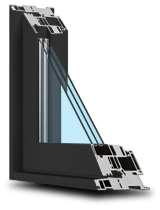Sliding Doors vs. Bi-Fold Doors: Pros, Cons & Design Impact
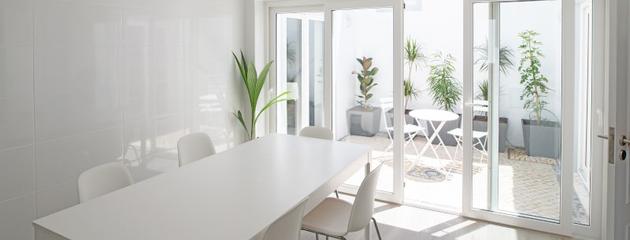
Key Takeaways
- Sliding doors operate on a fixed track system and are ideal for wide openings where wall space is limited.
- Bi-fold doors consist of multiple panels hinged together that fold against each other, offering a larger, uninterrupted opening.
- For limited space, sliding doors generally require less clearance but may offer a narrower passage compared to bi-folds.
- Bi-fold doors are often preferred in scenarios where full opening access is important, such as patio or garden entrances.
- Material choice, space configuration, and user preference play key roles in deciding which door system to install.
What are the main differences between sliding doors and bi-fold doors?
When choosing a door system for your home or renovation project, understanding the fundamental differences between sliding and bi-fold doors is critical. Each type brings unique mechanical designs, spatial requirements, and aesthetic outcomes.
Basic Mechanism & Operation
Sliding doors operate along a fixed, horizontal track. One or more panels slide past a stationary panel or wall pocket. They’re commonly used in patios or balconies and are favoured for their smooth, quiet operation and minimal footprint.
Bi-fold doors , in contrast, are composed of multiple panels connected via hinges. These panels fold and stack neatly against one or both sides of the opening, similar to an accordion. A track system guides the fold, available in either top-hung or bottom-rolling configurations.
Tony Wong, Project Manager at Canadian Choice Windows & Doors , explains:
“Sliding doors are more straightforward in design, while bi-fold systems provide a level of openness and seamless indoor-outdoor integration rarely matched by other configurations.”
Space Requirements
Sliding doors require lateral space to accommodate the sliding panel, but they don’t intrude into the room or exterior. Their compact nature makes them ideal for tight areas where swing clearance is limited.
Bi-fold doors, while folding onto themselves, still need clearance at the stacking area. They may slightly protrude into the room or outdoor space when opened. However, they allow nearly the full width of the opening to be utilized.
Comparative Table: Sliding vs. Bi-fold Doors
| Feature | Sliding Doors | Bi-fold Doors |
|---|---|---|
| Operation | Slide horizontally on a track | Fold and slide on a track via hinges |
| Space Efficiency | Requires space along wall/panel | Requires stacking space on one or both sides |
| Opening Width | Partial (usually 50%) | Full (up to 90–95%) |
| Aesthetic Impact | Minimalist and modern | Bold, open feel with visual segmentation |
| Ease of Use | Simple sliding motion | Requires more force to fold and slide |
| Installation Complexity | Lower | Higher |
| Best Use Cases | Patios, balconies, and small interiors | Garden access, wide openings, room dividers |
Which door type is better for a limited space: sliding or bi-fold?
In homes with limited space, door systems must maximize usability without compromising comfort. Both sliding and bi-fold doors offer potential solutions, but they serve different priorities depending on the specific layout and usage.
Sliding Doors: The Minimalist's Solution
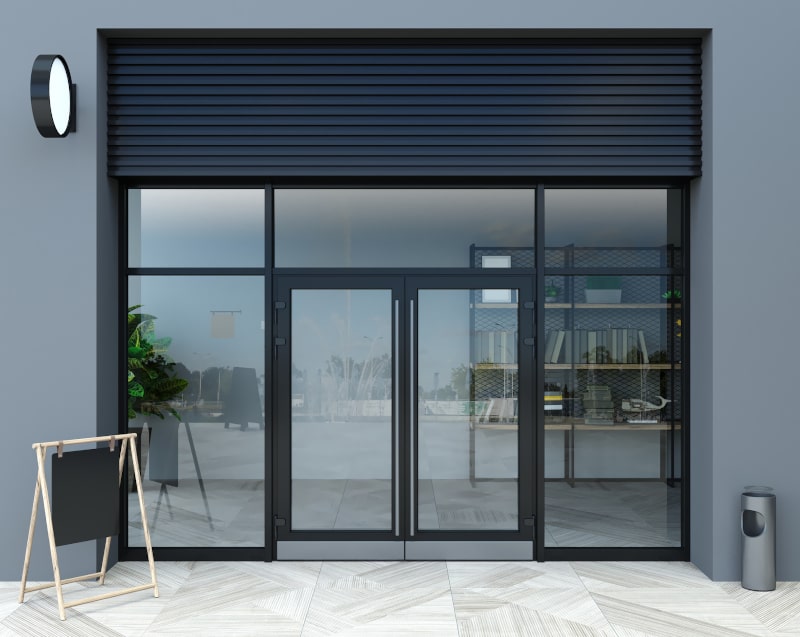
Sliding doors are perfect for homes where furniture or architectural elements restrict door swing. Their flat-plane motion means they don’t project inward or outward. This is especially useful in:
- Condos and apartments where every inch counts
- Narrow corridors or walk-out balconies
- Kitchens and utility rooms
Because only half the opening can be used at a time, access is limited; however, privacy and insulation tend to be better due to the fixed panel.
Bi-fold Doors: The Wide Access Option
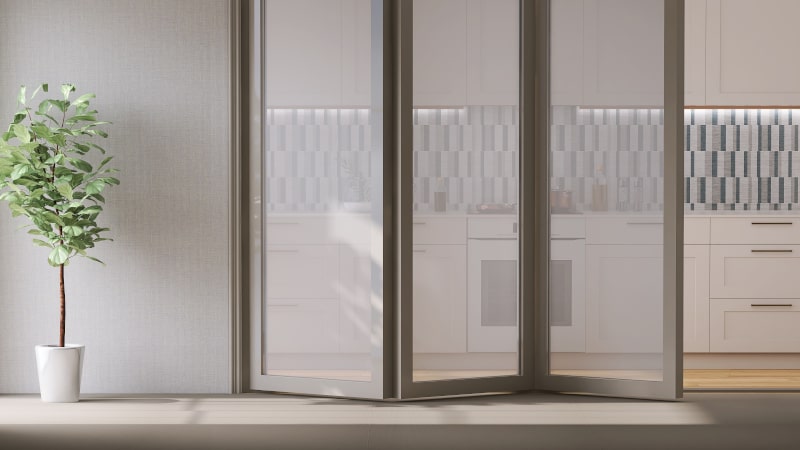
Bi-fold doors require slightly more room when opened, but allow you to clear nearly the entire doorway. This is advantageous when:
- Moving large items between indoors and outdoors
- Hosting gatherings where space flow matters
- Maximizing ventilation in warmer months
However, they may not be suitable for spaces where wall clearance is restricted on either side.
Space Efficiency
| Criteria | Sliding Doors | Bi-fold Doors |
|---|---|---|
| Clear Opening Provided | ~50% of the frame | ~90–95% of the frame |
| Wall Clearance Needed | Minimal | Moderate (for stacking panels) |
| Furniture Placement Flexibility | High | Medium |
| Maintenance | Lower (fewer moving parts) | Higher (more hardware components) |
What is a bi-fold door, and how does it work?
A bi-fold door is a type of door system consisting of two or more panels connected by hinges that fold against each other. These panels run along a track — either top-hung or bottom-rolling — and open in a concertina style.
How It Works: Step-by-Step
- Unlock the door using the central handle or latch.
- Initiate the fold by pulling/pushing the lead panel.
- Panels slide and fold simultaneously along the guided track.
- Stacking occurs at one or both ends of the opening.
Most bi-folds are designed with magnetic catches or stops to hold them open securely.
Typical Materials
- Aluminum: Lightweight, durable, often thermally broken for insulation
- uPVC: Cost-effective and easy to maintain
- Wood: Offers warmth and aesthetic appeal, but requires regular upkeep
- Composite: Combines material strengths for durability and thermal performance
Ideal Placement
Bi-fold doors work well in:
- Garden or patio entrances where full opening access is desired
- Interior dividers for open-plan spaces like kitchens and lounges
- Sunrooms or conservatories to maximize light and flow.
They’re also popular in premium renovations due to the sense of luxury they bring by blending indoor and outdoor zones.
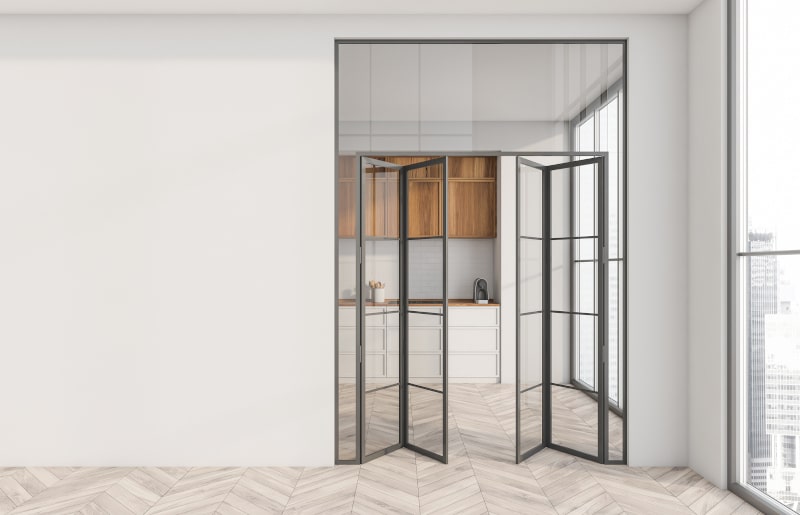
How do bifold glass patio doors affect natural lighting and energy efficiency?
Glass bi-fold patio doors have a significant impact on both the visual and thermal qualities of a living space. Their large glazed surfaces naturally amplify daylight while advanced coatings and frame technologies ensure efficient insulation.
Natural Light Enhancement
- Wide openings allow for substantial daylight penetration.
- Modern bi-folds often feature floor-to-ceiling glass, transforming rooms into brighter, more welcoming spaces.
- Depending on orientation, south- or west-facing bi-folds can reduce the need for artificial lighting during the day.
Energy Efficiency Features
- Low-E glass coatings help reduce heat transfer while allowing visible light to pass through.
- Argon gas fills the space between double- or triple-glazed panes to enhance insulation.
- Thermally broken aluminum frames reduce cold bridging, a common issue in metal-framed doors.
Helen Sin, Consumer Success Manager at Canadian Choice Windows & Doors, states:
“ENERGY STAR-certified bi-fold doors enhance thermal efficiency, lowering seasonal energy costs and reducing drafts in colder Canadian climates,”
Thermal and Visual Impact
| Feature | Benefit |
|---|---|
| Low-E Glass | Reflects heat, minimizes UV rays |
| Double/Triple Glazing | Enhances insulation and soundproofing |
| Thermal Break Technology | Prevents heat loss through metal frames |
| Tinted/Obscure Glass Options | Adds privacy without compromising light flow |
| Smart Glass (optional) | Adaptive tinting for light and heat control |
Privacy and Glare Control
Large glazed doors can pose privacy concerns. Fortunately, modern solutions include:
- Integrated blinds between glass panes
- Tinted or frosted glass options
- Smart glass that tints automatically
These additions enable homeowners to strike a balance between transparency and privacy while maintaining efficient light flow.
What are the pros and cons of folding sliding doors in modern designs?
Folding sliding doors — often referred to as bi-fold doors — are a defining element in contemporary architecture. Their functionality, aesthetics, and spatial impact are major selling points. But like any design element, they come with pros and cons.
Advantages
- Wide Opening Span: Ideal for blending indoor and outdoor spaces.
- Modern Aesthetic: Clean lines and large glass panels enhance the open-plan living experience.
- Flexible Configurations: Available in 2- to 8-panel setups.
- Custom Finishes: Frames are available in wood, aluminum, or composite, matching any design theme.
- Increased Property Value: Frequently featured in high-end renovations.
Disadvantages
- Complex Hardware: Hinges, rollers, and tracks require regular maintenance.
- Higher Cost: Custom sizes and finishes can significantly raise the price.
- Thermal Bridging Risks: If improperly insulated, heat loss can occur.
- Security Concerns: Multiple panels and locks may need upgraded security features.
Pros and Cons
| Aspect | Pros | Cons |
|---|---|---|
| Aesthetics | Stylish, luxurious, fits modern designs | May clash with traditional home exteriors |
| Functionality | Large opening width, flexible use | More complicated to operate than single doors |
| Durability | Strong materials like aluminum or composite | Hinges and rollers sare ubject to wear over time |
| Cost | Adds home value, premium feature | Higher upfront and maintenance costs |
| Security | Multi-point locks available | Requires more lock points to secure multiple panels |
What are the best alternatives to sliding doors for tight spaces?
Not every space suits a traditional sliding or bi-fold door. Fortunately, modern design offers several clever alternatives that maximize accessibility without demanding much clearance.
Pocket Doors
These doors slide into a hidden wall cavity when open, completely disappearing from view.
- Ideal for : Bathrooms, closets, and minimalist interiors
- Pros : Zero swing clearance, full opening access
- Cons : Requires wall modifications or pre-planning
Accordion Doors
Accordion doors are similar to bi-folds but often lighter and more flexible. Typically used indoors.
- Ideal for : Pantries, utility areas, or room dividers
- Pros : Affordable, space-saving, quick to install
- Cons : Less durable, limited security or insulation
Stacked Panel Systems
This option allows multiple panels to slide and stack behind one another or into a wall pocket.
- Ideal for : Large openings in premium modern homes
- Pros : Wide open access, sleek aesthetics
- Cons : Higher cost, more complex installation
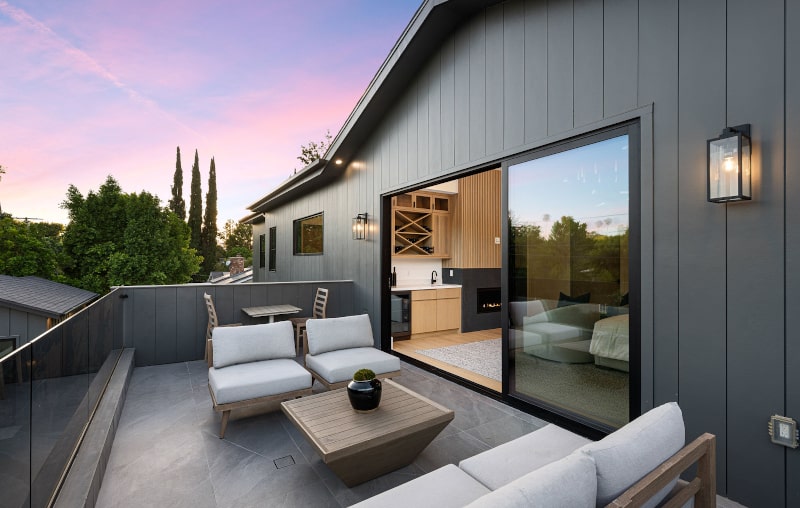
Which door type offers better security features for homes?
Security is a critical factor when evaluating any door system for Canadian homes. Both sliding and bi-fold doors have evolved to meet modern security standards, but they differ in hardware complexity, glass type, and frame strength.
Locking Mechanisms
- Sliding Doors typically use a multi-point lock or hook-and-bolt system. Security is improved when reinforced locks and anti-lift devices are installed.
- Bi-fold Doors often feature multi-point locking systems on the lead door, plus shoot bolts on intermediate panels. These can offer excellent protection if properly aligned.
Glass and Frame Security
- Shatterproof or laminated glass significantly increases security for both types.
- Aluminum frames with internal reinforcements are considered most secure.
- Look for products certified by the CSA Group or ENERGY STAR Canada, which have been tested for impact resistance and durability.
Security Features
| Feature | Sliding Doors | Bi-fold Doors |
|---|---|---|
| Locking Mechanism | Hook locks, multi-point (2–4 points) | Multi-point lock, shoot bolts |
| Glass Options | Laminated, tempered, double/triple glazing | Laminated, impact-resistant glazing |
| Frame Strength | Aluminum, uPVC with steel reinforcements | Aluminum or composite |
| Security Rating | Moderate to High (with upgrades) | High (witha complete locking system) |
What are the costs of sliding and bi-fold doors, including installation?
Cost considerations play a significant role in determining whether to choose sliding or bi-fold doors. Sliding doors tend to be more affordable than bi-folds, but pricing depends on the materials, size, and complexity of installation.
Hidden Costs to Watch
- Custom sizing can increase cost by 25% or more.
- Glazing upgrades, such as triple-pane or smart glass, can add $500–$2,000.
- Structural adjustments (widening openings or wall reinforcement) may be required.
- Permits and inspections vary by province.
Long-Term Value
- Sliding doors are easier and cheaper to maintain.
- Bi-folds, when properly installed and weather-sealed, are energy-efficient and add aesthetic appeal.
- Canadian homeowners in areas with extreme temperature fluctuations should consider investing in high-performance glazing, regardless of the door type.
Which door is right for your home?
Choosing between sliding and bi-fold doors depends on your priorities, including space, cost, aesthetics, and usage. Here’s a final side-by-side overview to guide your decision.
Sliding vs. Bi-fold Doors
| Feature | Sliding Doors | Bi-fold Doors |
|---|---|---|
| Operation | Slides on a track | Folds and stacks on track |
| Space Efficiency | High | Medium (stacking space needed) |
| Opening Width | ~50% | ~90–95% |
| Aesthetics | Sleek, minimal | Expansive, modern |
| Security Features | Strong (with upgrades) | Excellent (multi-lock + reinforced glass) |
| Energy Efficiency | Good (double/triple glazing) | Excellent (with Low-E & thermal breaks) |
| Maintenance | Low | Moderate (hardware upkeep) |
| Cost | Lower upfront | Higher, but greater ROI |
| Installation Complexity | Simple to moderate | Moderate to complex |
Sources Used
- Canadian Standards Association — https://www.csagroup.org/
- Natural Resources Canada — https://natural-resources.canada.ca/
- ENERGY STAR Canada — https://www.energystar.gc.ca/
- HomeStars — https://homestars.com/
1000’s of Colours & Textured Finishes
Transform your home from ordinary to extraordinary with our new coloured and non-glare textured finishes. Available in a wide array of colours as well as custom matched colours for your very own personalized design.
Our Most Popular Replacement Window Colours:






